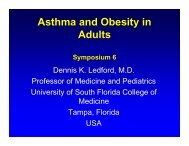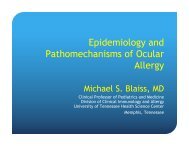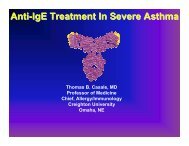Dubai Final-v20.indd - World Allergy Organization
Dubai Final-v20.indd - World Allergy Organization
Dubai Final-v20.indd - World Allergy Organization
Create successful ePaper yourself
Turn your PDF publications into a flip-book with our unique Google optimized e-Paper software.
ABstrACts<br />
ABstrACts<br />
3107<br />
EXPErimEnTallY UnraVEling THE aToPiC marCH<br />
Wilson, m. s.<br />
molecular immunology, nimr, mrC, london, United Kingdom.<br />
Experimentally Unraveling the atopic march.<br />
mark s. Wilson. molecular immunology Division. national instiutes for medical research, mrC. mill Hill. london. UK.<br />
the sequential progression of allergic symptoms from atopic eczema, food allergy, rhinitis and asthma have been widely reported<br />
and referred to as ‘the Atopic march’. Co-morbidities of allergic conditions and the over-dispersed distribution of allergic diseases<br />
within few individuals have also been identified. these data suggest that allergic diseases may be linked; however the relationships<br />
between allergic symptoms are unclear. to separate cause from consequence, we are investigating the immunological interactions<br />
between these disease phenotypes and have developed experimental models of allergic asthma, allergic rhinitis and food allergy.<br />
these models are used to ask whether food allergy, and/or upper airway rhinitis influence the development of lower airway<br />
asthma. mice sensitized and orally challenged with crude peanut antigen (CPA) are subsequently sensitized and challenged, in the<br />
lower airways, with house dust mite (HDm). A cohort of peanut-allergic mice will also be sensitized and challenged in the upper<br />
airways with ragweed (rW) prior to lower airway HDm challenge. We hypothesize that peanut allergy and rW-induced rhinitis will<br />
exacerbate HDm-sensitization (igE) and HDm-induced airway inflammation. the molecular mechanisms of such interactions will<br />
be investigated and tested. Our studies and latest observations will be presented. This work is supported by the Medical Research<br />
Council (MRC), UK.<br />
3108<br />
a noVEl rolE For THE ComPlEmEnT rEgUlaTor CD46 in EPiTHElial TigHT JUnCTion FormaTion/rEgUlaTion<br />
Al-shouli, s. t. 1 and Kemper, C. 2<br />
1 2 Clinical immunology and <strong>Allergy</strong>., King’s College london guy’s and s’t thomas’ Hospital, london, United Kingdom. mrC Centre for<br />
transplantation, london, United Kingdom.<br />
Background: the complement regulator CD46 has been shown to play a role in epithelial cell polarization and is overexpressed on<br />
epithelial tumor cells. it is clear that our understanding of the many functions of the complement system in health is growing but<br />
still not complete. it is therefore to be expected that complement will be connected in the future with additional human diseases.<br />
this research project focuses on just such a prediction: We have obtained data suggesting a novel role for CD46 in epithelial cell<br />
tight junction regulation and growth induction or restriction. these data suggest that complement may also play a previously<br />
unacknowledged role in another important human disease, colon cancer. Colon cancer is the third most common cancer in the<br />
UK with a poor prognosis because of a high mortality and recurrence rate, thus, there is a need to develop better treatments.<br />
methods: 1-Culture PtECs or Caco-2 cells for several days on 24 wells-plates to measure E-cadherin expression, CD46 expression,<br />
Cell-proliferation assessed and apoptosis induced in cells. 2- Culture the human kidney proximal tubular epithelial cells (PtECs)<br />
or the human intestinal cell line (Caco-2) for several days on transwells to measure transepithelial resistance (tEr) and Beads<br />
dextran. results: we found that CD46 interacts with E-cadherin and sPAK, both vital proteins in the maintenance of epithelial cell<br />
layer integrity. mutations in either protein cause colon cancer or iBD, respectively. Further, we observed that CD46 regulates tight<br />
junctions and by this transepithelial resistance and paracellular permeability. Based on these data we hypothesize that complement/<br />
CD46 communicates with the E-cadherin/catenin network in epithelial cells (via interaction/activation of sPAK) and contributes to<br />
normal epithelial cell barrier integrity. Further, defects in CD46-mediated signals leading to disturbance in its crosstalk with the<br />
E-cadherin/catenin network may be a factor in malignant transformation. Conclusion: our study was conducted to ascertain the<br />
biological properties of CD46 in a cell-cell adhesion network. We believe that this study helped to further solidify this idea and set<br />
the ground for more detailed future studies.<br />
3109<br />
THE rolE oF EXTErnal PHYSiCal ForCES in TriggEring THE allErgiC rEaCTionS<br />
Athota, r. r. 1 , reddy, r. r. K. 2 , neerupudi, K. B. 1 and sam, r. A. 3<br />
1 2 3 Biochemsitry, Andhra University, Visakhapatnam, india. Department of Physics, s K University, Anantapur, india. internal medicine,<br />
Christian medical College, Vellore, india.<br />
Background: in the era of scientific advancements, the allergic population is increasing at an alarming rate in modern urban<br />
society. in this context, the influence of the external forces like humidity and other physical forces in triggering the allergic<br />
symptoms is investigated.<br />
methods: the humidity has been measured in two cities namely Visakhapatnam, a coastal city and Anantapur, a non-coastal<br />
www.worldallergy.org 142<br />
FinAl PrOgrAm

















